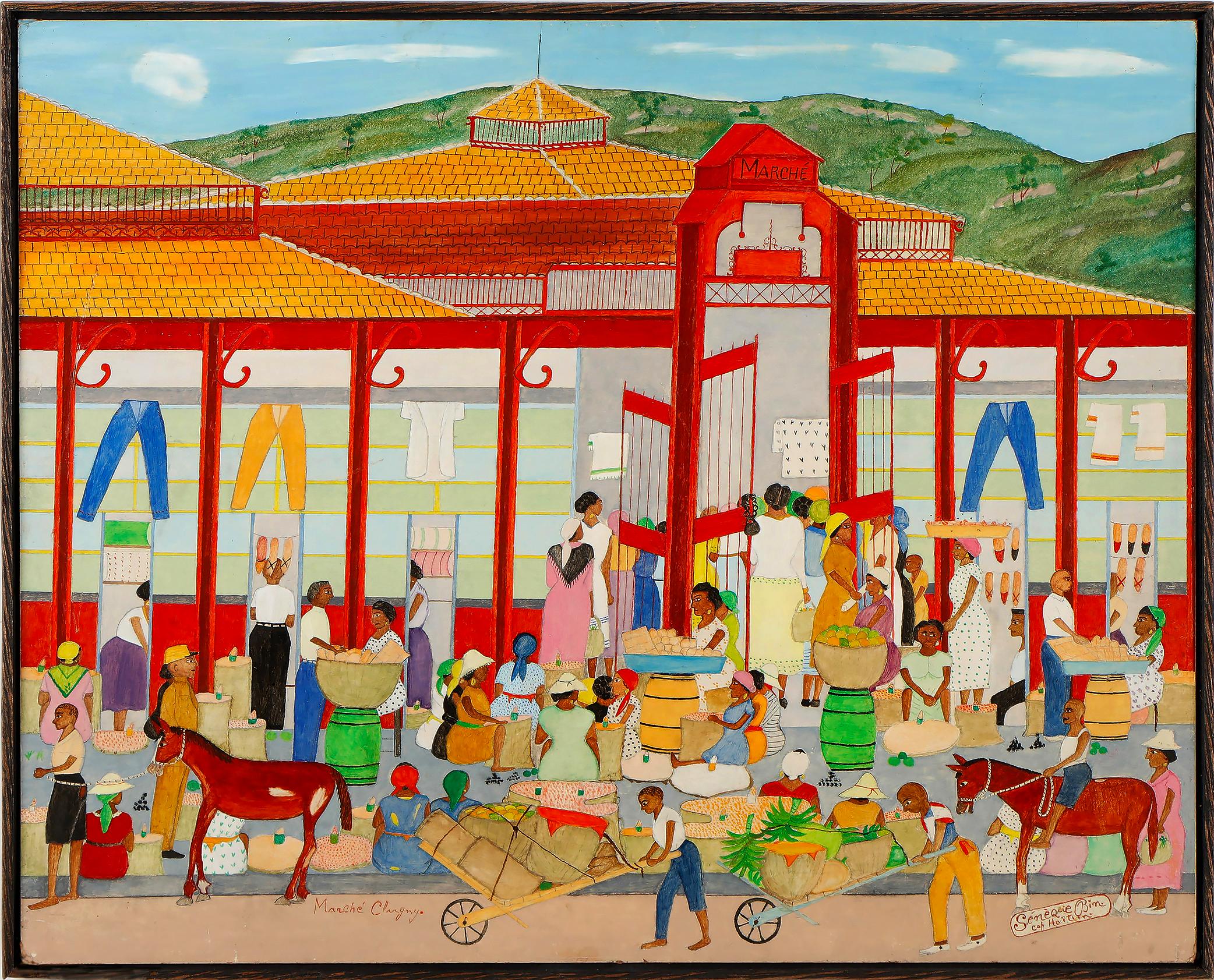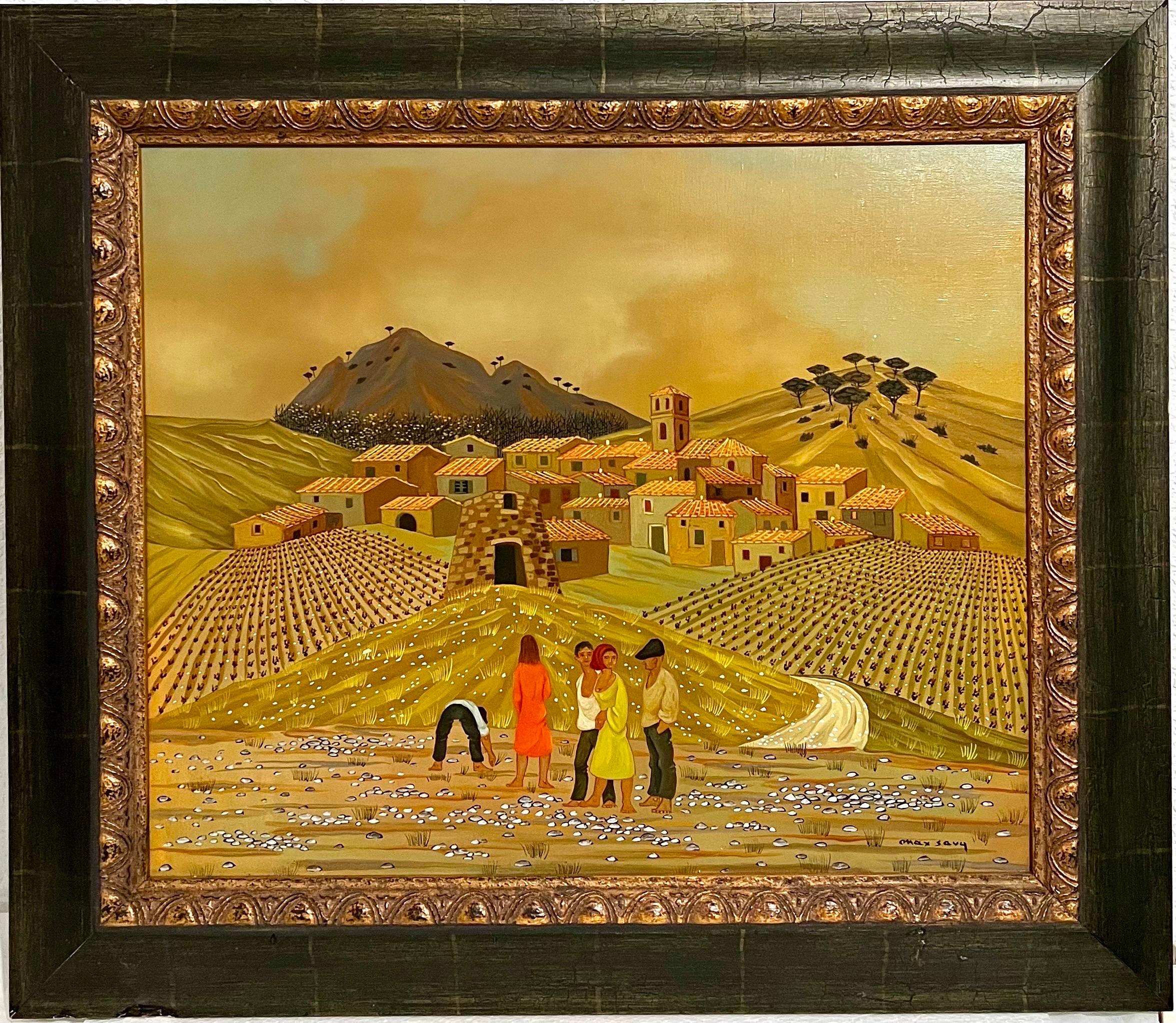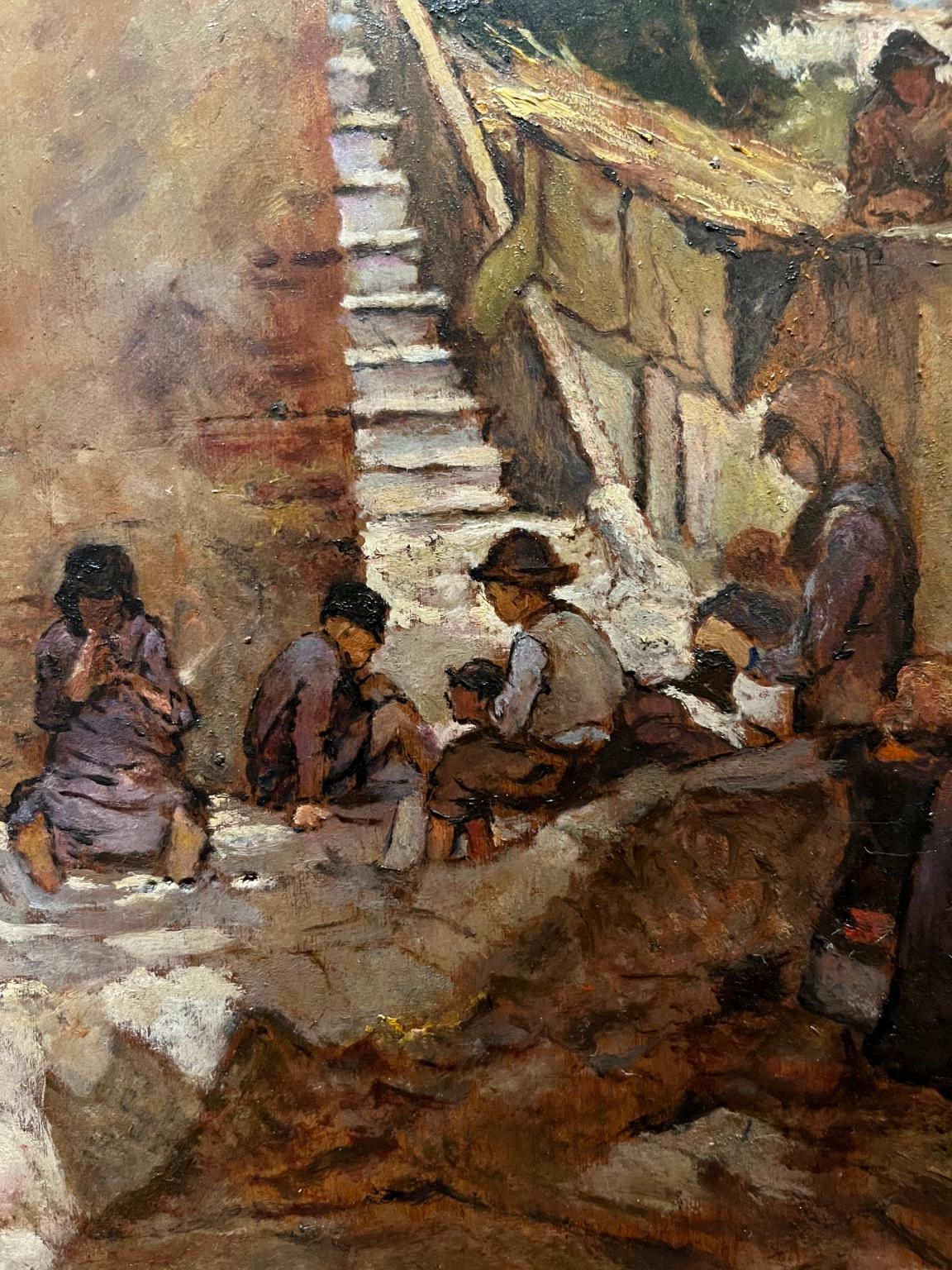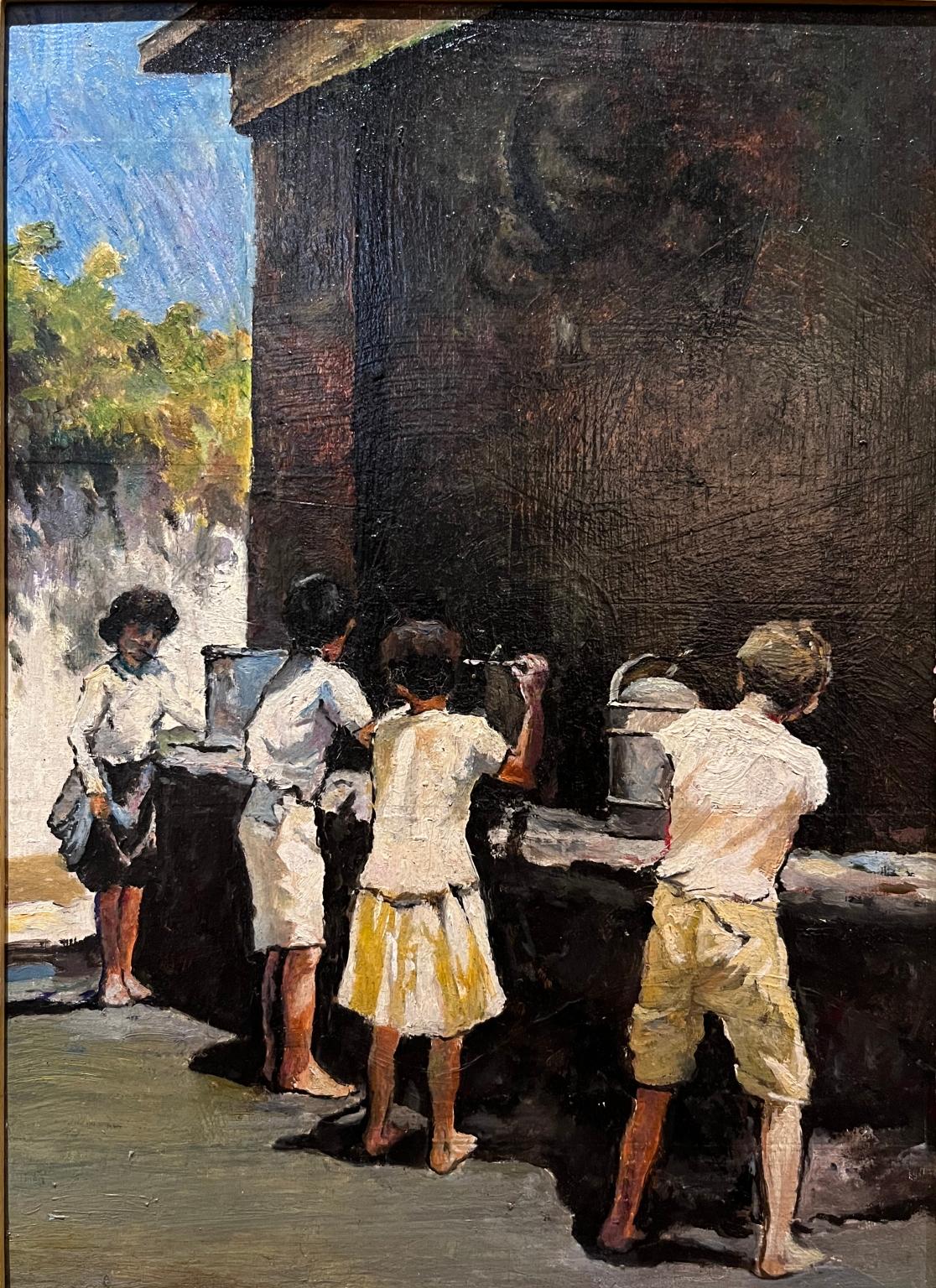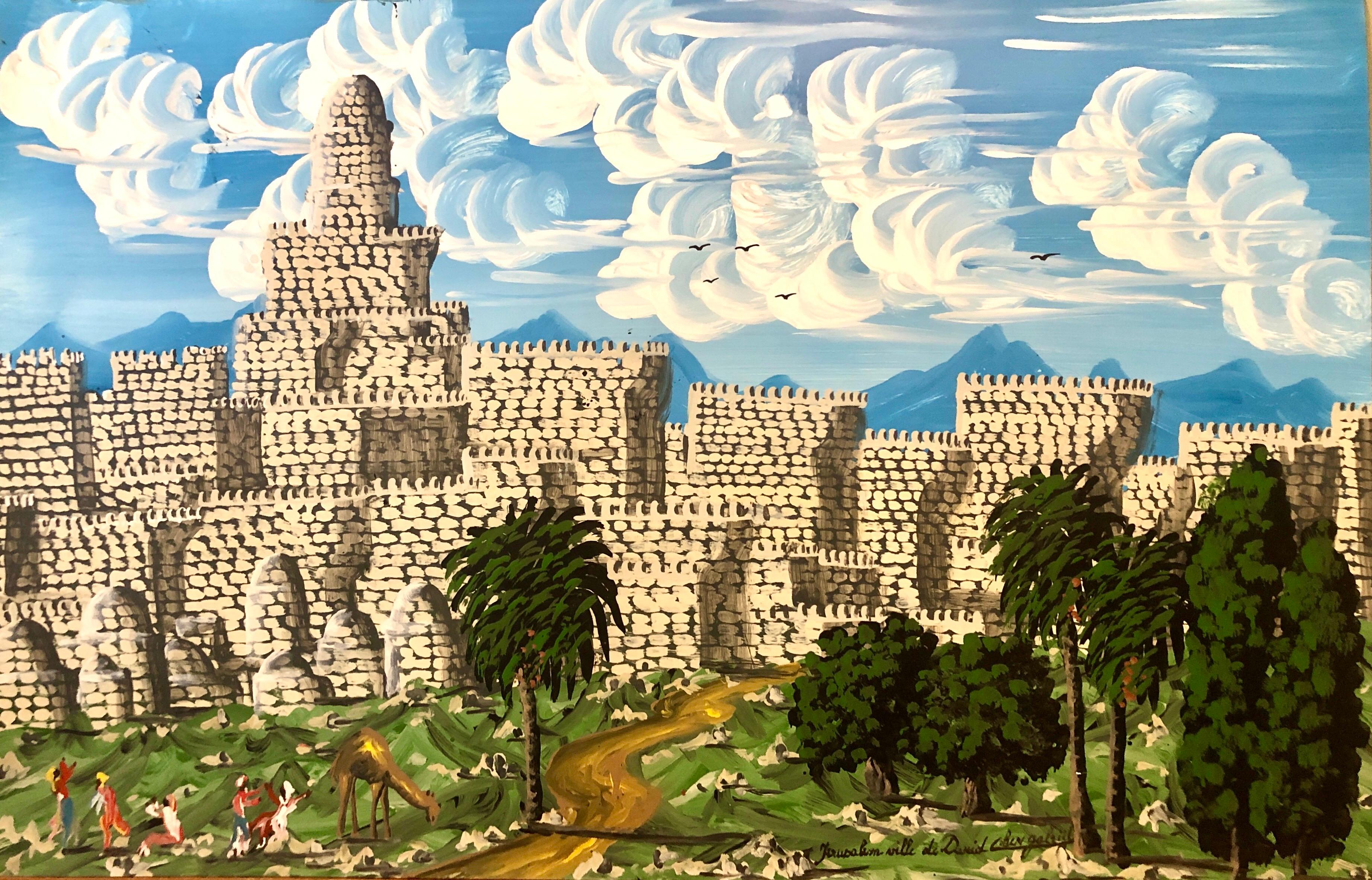Items Similar to Wedding (Authenticated Clementine Hunter Framed Black Folk Art Painting)
Want more images or videos?
Request additional images or videos from the seller
1 of 9
Clementine HunterWedding (Authenticated Clementine Hunter Framed Black Folk Art Painting)1967
1967
About the Item
If you have been watching the prices of Clementine Hunter's work over the past two years, you will know that they have soared to astronomical heights. Attached is the auction record for a sale in New York in January of 2023. Black artists have been in the spotlight lately, and while Clementine Hunter has been a big regional artist for a very long time, she's a national figure now and being added to many museum collections. Institutions and prominent collectors have moved in hard. I was really happy to get this one. At any rate, the first thing to ask about any Clementine is: is it authentic. Yes, there are fakes, and paintings by her son that are mistaken for (or presented as) hers. I won't touch anything by her that hasn't been verified, and this one has been verified by the #1 Clementine expert, Tom Whitehead. Of course it has my own guarantee as well; I have sold many Clementines. You can find fakes at auction houses (many of them outside of the New Orleans area) and other venues that don't ask questions, for a lot less money, but don't be fooled!
Now, about the painting. This one has a clear, wonderful provenance, which is unusual for these. Weddings were a common theme for Hunter, but this one has a specific history. It was gifted to Mr. and Mrs. Merrill by Ann and Jack Brittain in 1967 as a wedding present; then went by descent to the estate of Mary Jane "Cookie" Grace Merrill of Baton Rouge, Louisiana. 18" x 24", slightly larger with frame. I will be including a free copy of the hardcover book (show in photo) by Art Shiver and Tom Whitehead about Clementine (Whitehead is the expert who verified this painting). Proudly presented by Guy Lyman Fine Art, New Orleans, with our firm guarantee of satisfaction.
From AskArt:
Often referred to as “the black Grandma Moses,” Clementine Hunter painted four to five thousand paintings, which were boldly colored images in folk art style of plantation life in Louisiana. Her subjects included everyday activities such as doing laundry and festive events including weddings, dances, and church going. She also did mural painting, and a number of her works had Christian religious subjects.
She was born at Hidden Hill Plantation near Natchitoches, Louisiana, and lived there the remainder of her life pf one-hundred-one years, raising seven children and working in the fields. She attended a local Catholic school, but quit at a young age and never learned to read or write. At age sixteen, she moved to nearby Melrose Plantation, where she worked for many years as a field hand.
Her first male companion and father of two of her children was Charlie Dupree, who died in 1914. Ten years later she married Emanuel Hunter, and moved into the plantation house where she was in charge of the domestic work. Becoming associated with the plantation mistress, Ms. Cammie Henry, changed Hunter’s life. Henry, was an archivist and artist who actively encouraged the arts. She opened her home to artists and authors who needed a quiet place to work. It was at Melrose that Hunter first began her production of hand made quilts, dolls, and lace curtains.
Meeting artist friends of Ms. Henry, Hunter met many people in the art world and was especially influenced and promoted by Francois Mignon, who was an artist-in-residence at the plantation. In 1946, under his direction, she did her first work, a plantation baptism scene, from a few partially used tubes of oil paint on a window shade that he provided. Another supporter at that time was James Register, also an artist-in- residence, and he obtained a Julius Rosenwald Foundation Grant for her. He encouraged her to do abstract art, which she did while letting him choose the titles.
But she preferred the folk art style. From that time, she was prolific, and created over four-thousand scenes of plantation life on whatever materials were available from scrap wood to paper bags. She thinned her oil paint so much it resembled watercolor. She sold many of her first works for a dime or quarter to pay for her husband’s medical treatment.
Legacy and honors:
One of the more well-known displays of Hunter’s artwork is located in a food storage building called “African House” on the grounds of Melrose Plantation. (African House is often referred to as slave quarters, however the building was built for, and always used for food storage.) The walls are covered in a mural Hunter painted in 1955, depicting scenes of Cane River plantation life. When she completed the mural, a local newspaper ran the headline: “A 20th Century Woman of Color Finishes a Story Begun 200 Years Ago by an 18th Century Congo-Born Slave Girl, Marie-Therese, the original grantee of Melrose Plantation.”
The cafe and snack bar at the Alexandria Museum of Art is named for Hunter.
She was the first African-American artist to have a solo exhibition at the Delgado Museum (now the New Orleans Museum of Art). She achieved significant recognition during her lifetime, including an invitation to the White House from U.S. President Jimmy Carter and letters from both President Ronald Reagan and U.S. Senator J. Bennett Johnston, Jr..
Radcliffe College included Hunter in its Black Women Oral History Project, published in 1980. Northwestern State University of Louisiana granted her an honorary Doctor of Fine Arts degree in 1986. The following year, Louisiana governor Edwin Edwards designated her as an honorary colonel, a state honor, and aide-de-camp.
Hunter has been the subject of biographies and artist studies, and inspired other works of art. In 2013 composer Robert Wilson presented a new opera about her: Zinnias: the Life of Clementine Hunter, at Montclair State University in New Jersey.
Sources:
Peter Hastings Falk, Editor, Who Was Who in American Art, Volume II
Chuck and Jan Rosenak, Museum of American Art Folk Art Encyclopedia
“Clementine Hunter,” Wikipedia, Web, Mar. 2016
Alice Rae Yelen, “Passionate Visions,” American Art Review, February, 1995
- Creator:Clementine Hunter
- Creation Year:1967
- Dimensions:Height: 18 in (45.72 cm)Width: 24 in (60.96 cm)
- Medium:
- Movement & Style:
- Period:
- Condition:
- Gallery Location:New Orleans, LA
- Reference Number:1stDibs: LU99439363492
About the Seller
5.0
Gold Seller
These expertly vetted sellers are highly rated and consistently exceed customer expectations.
Established in 2008
1stDibs seller since 2018
271 sales on 1stDibs
Typical response time: 7 hours
- ShippingRetrieving quote...Ships From: New Orleans, LA
- Return PolicyA return for this item may be initiated within 14 days of delivery.
More From This SellerView All
- The Kindling Gatherers, 1890 (knighted Royal Academy member, Antique Landscape)By Alfred EastLocated in New Orleans, LASir Alfred East was both a full member of the Royal Academy and president of the Royal Society of British Artists, so his pedigree is impeccable. He be...Category
Late 19th Century Impressionist Landscape Paintings
MaterialsOil
- A Path Through the Woods (Impressionist Oil on Canvas)Located in New Orleans, LAA gentle Impressionist scene of a pretty young woman on a trail in the forest in dappled light. Written on the back is "M. Graves 48" but the canvas and stretcher seem a lot older th...Category
Early 20th Century Impressionist Landscape Paintings
MaterialsOil
- "Le Dompteur de Pigeons" (ex. Christie's) - Large Antique Impressionist PaintingBy Georges Jules Victor ClairinLocated in New Orleans, LAA large, spectacular, absolutely splendid painting by noted French painter Georges Clairin, which appeared for auction at Christie's in 2004 (see photo...Category
Late 19th Century Impressionist Landscape Paintings
MaterialsOil
- "Shoes" - Late 20th Century City Figure PaintingLocated in New Orleans, LAIn addition to having his work in museums and fine corporate collections, Alabama artist Donny Finley showed for years at prestigious Bryant Galleries on ...Category
Late 20th Century American Realist Landscape Paintings
MaterialsOil
- "New Orleans Streetcar" - Large Contemporary Mixed Media Collage PaintingBy Gunner DongieuxLocated in New Orleans, LAAnyone who has visited New Orleans knows it's crammed with characters of every description. Important emerging artist Gunner Dongieux (New Orleans, San Francisco) grew up in the Big Easy, and here has captured the eccentricity which characterizes the city. You can see all sorts of characters here - even Fred Flintstone...Category
2010s Pop Art Figurative Paintings
MaterialsMixed Media, Acrylic
- Gunner Dongieux "All Quiet on the Western Front" - Contemporary Collage PaintingBy Gunner DongieuxLocated in New Orleans, LAA large and endlessly entertaining painting combining acrylic and collage, by important emerging artist Gunner Dongieux (New Orleans, San Francisco). Part of the Breakup Series, whic...Category
2010s Pop Art Figurative Paintings
MaterialsMixed Media, Acrylic
You May Also Like
- Marché Cluny - Market at Cap-Haitien - Haitian Street ArtLocated in Miami, FLA bustling street scene of everyday life in front of the famed Marché in Cap-Haïtien is rendered in Sénèque This is a relatively early work by Obin's signature brightly colored and flat naive style. Signed lower right. Provenance: Galerie Issa - Port-Au-Prince, Haiti - Owned by Issa El Saieh of later named El Saieh Gallery Sénèque Obin...Category
1950s Outsider Art Landscape Paintings
MaterialsOil, Masonite
- Naive London Street Scene Folk Art Oil Painting Big Ben, Parliament, Union JackBy Andrew MurrayLocated in Surfside, FLBig Ben, House of Parliament with Union Jack flag, Thames River, boats, barges, airplane and double decker red bus. Classic London street scene. 24 inches by 11 inches in a frame 24.5 inches by 11.5 inches. ANDREW MURRAY became known and loved as an imaginative Naive painter who captured the character of cities (especially Cape Town and London) with humorous and affectionate insight. An English counterpart to Michel Delacroix of Paris and Charles Fazzino of New York He was born in north China, the son of a missionary. As a child of five he had his first lesson in painting from the son of another, the 10-year- old Mervyn Peake...Category
20th Century Folk Art Figurative Paintings
MaterialsCanvas, Oil
- French Folk Art Naive Oil Painting Workers in Vineyard, Les Vignes aux GitansLocated in Surfside, FLMax Savy Oil on canvas painting depicting a village scene with winemakers in a vineyard by artist Max Savy (French, b. 1918). Signed in the lower right. Frame measures 24.5 inches x 28 inches. canvas is 18 X 22 inches., Perfect for a wine cellar or cave. Max Savy (French, 1918-2010) painted scenes of everyday life in the French Corbieres region, which garnered much success during his life. Though the artist remained silent about his early life, it's known his father instilled in him a belief in the humanist socialism philosophy of French Socialist Party leader, Jean Jaures. In 1938, at age 20, he moved to Carcassonne to attend school. There, he married and settled into a teaching position, joining the French Resistance during World War II and earning the Cross of the Combatant. After the war, he created the work for which he is most admired. Max Savy paintings are part of France's heritage collection, and the artist became a knight of the National Order of Merit in 1973. Max Savy's paintings and artworks include scenes of peasants in the fields. Max Savy was active/lived in France. Max Savy is known for folk art style painting of village architecture, vintners, figures in landscape, wine makers, marine scenes. His work is similar in style to the naive, folk art paintings of Michel Delacroix and Fanch Ledan. This is quite similar to a work I had titled "Les Vignes Aux Gitans" (the gypsy grape vines) So i assume this is also a vineyard painting...Category
Mid-20th Century Folk Art Landscape Paintings
MaterialsCanvas, Oil
- Tuscan Figurative Genre Scene painting 20th century oil on canvasLocated in Florence, ITThe artist of this painting is unknown but it can be ascribe to a Tuscan movement of the 20th century inspired by 19th century art like Verismo (as we can deduce by the clean and not...Category
20th Century Folk Art Figurative Paintings
MaterialsCanvas, Oil
- Tuscan Figurative Genre Scene painting 20th century oil on canvasLocated in Florence, ITThe artist of this painting is unknown but it can be ascribe to a Tuscan movement of the 20th century inspired by 19th century art like Verismo (as we can deduce by the clean and not...Category
20th Century Folk Art Figurative Paintings
MaterialsCanvas, Oil
- Large Israeli Naive Art Screen Enamel Oil Painting Jerusalem Old City Folk ArtBy Gabriel CohenLocated in Surfside, FLJERUSALEM, Vielle du David, (City of David) Superlac (enamel) painting on paper, hand signed, titled and dated. Provenance: Michael Hittleman Gallery Los Angeles. Gabriel Cohen, (French-Israeli) Self taught, Naive painter was born in Paris in 1933, to parents from Jerusalem with a father who studied the kabbalah. Throughout World War II, the family hid from the Nazis in Paris. Images of Nazi soldiers appear in several of his paintings. In 1949, when Gabriel was 16, the family returned to Israel. They managed to save enough money to move back to the quarter where both parents were born: Ohel Moshe in Nachlaot. Gabriel served in the artillery corps and after the army, went back to live in his parents' house and earned a living polishing diamonds. The head of the polishing plant, who noticed his employee's artistic skill, allowed him to paint during work hours. He once asked Cohen if he could draw a tiger. Cohen drew him a tiger. And he did a lot of sculpting and painting on glass. He also loved to play the guitar, especially flamenco style. Critics say he is one of Israel's greatest naive-style painters. Along with Shalom of Safed, Kopel Gurwin and Natan Heber, He is renowned as one of Israel's greatest living naive-style folk art painters, recipient of the Jerusalem Prize for Art (1987), a permanent entry in encyclopedias of naive painting, who exhibited his work not only in Israel, but also in Paris, Venezuela, Denmark and Germany; the same Gabriel Cohen whose colorful , bold Naif paintings were exhibited at the Jewish Museum in New York in 1987 alongside works by Marc Chagall; the same Gabriel Cohen about whom curator and art scholar Gideon Ofrat says, "There is no questioning his greatness." He has shown in Paris on the Rue de Rosiers in the Marais. His impressions of his journeys, mostly imaginary, yet some real, are expressed in Cohen's paintings. Huge, colorful canvases rich in precise detail and fantasy, in which he paints the Eiffel Tower and the Russian steppes or the vistas of Paris and the Tower of Babel "In my opinion, it's also because the Tower of Babel has some kind of phallic, erotic meaning, but also because of the internationalism, of the mixture and confusion of nations, which is an essential element in Gabi Cohen's work," says Gideon Ofrat. There is no superlative that has not been lavished on Cohen's work by art critics, since he began showing his paintings at age 40, All the art critics seemed to agree at once that Cohen is one of the greatest naive-style painters in Israel. Their counterparts abroad seconded this view. About a year and a half ago, Zadka organized a show for Cohen at the Jerusalem Artists' House. The Tel Aviv Museum bought a painting of Gabi's and so did the Israel Museum, and several artists bought his drawings. He is a great, great painter. There is no painter who is more of a symbolist and illustrative artist than he is. As a painter myself, I admire him." The Yom Kippur War in 1973 sparked an artistic breakthrough for Cohen; it was at that time that he began to sit on the sidewalk after his work as a diamond polisher and paint. Not long afterward, in early 1974, he did a painting he called "Moses on the Mountain." Ruth Debel, of the Debel Gallery in Ein Kerem, passed by and saw it on the street. She asked how much he wanted for it, and for the first time in his life, he realized that his work had financial value. His first show was at the Debel Gallery in 1974. The response was overwhelming. Cohen was immediately declared a genius. His paintings at the gallery were purchased and he continued to create new paintings. That same year, he was invited to take part in a group exhibition of naive artists at the Kunsthaus in Zurich, and a year later, his work was included in a traveling show of naive-style artists from Israel that was exhibited in Denmark and Germany. Soon after that he was invited to be part of group shows in Venezuela and at the Tel Aviv Museum. Cohen had four solo shows at the Debel Gallery. Awards And Prizes 1987 Jerusalem Prize for Painting and Sculpture 1999 Shoshana Ish-Shalom Prize for special contribution to art, Jerusalem He has exhibited alongside all of the Israeli great artists. included in the Naive Art Group exhibition Gvanim Art Gallery, Jerusalem Rubin, Rachel Roman, Yitzhak Zarembo, Leah Moscovitz, Shalom (of Safed) Steinberg, Michael Denisov, Salva Harbon, Haim Cohen, Gabriel Chanannia, Joseph (Jojo) Local Hero...Category
20th Century Folk Art Landscape Paintings
MaterialsPaper, Oil, Alkyd
Recently Viewed
View AllMore Ways To Browse
Vintage Art Style
Vintage Wood Painting Frames
Vintage Met Art
Vintage Newspaper Art
Vintage Folk Art Paintings
Hunter Century
Vintage Black Folk Art
Food Vintage Art
Vintage Bar Wall Art
Catholic Art
Lot Of Vintage Frames
Vintage Camping Art
Vintage Hunter
Women Outside Art
Black Folk Art Painting
Vintage Childrens Book Art
Vintage Medical Art
Laundry Art
